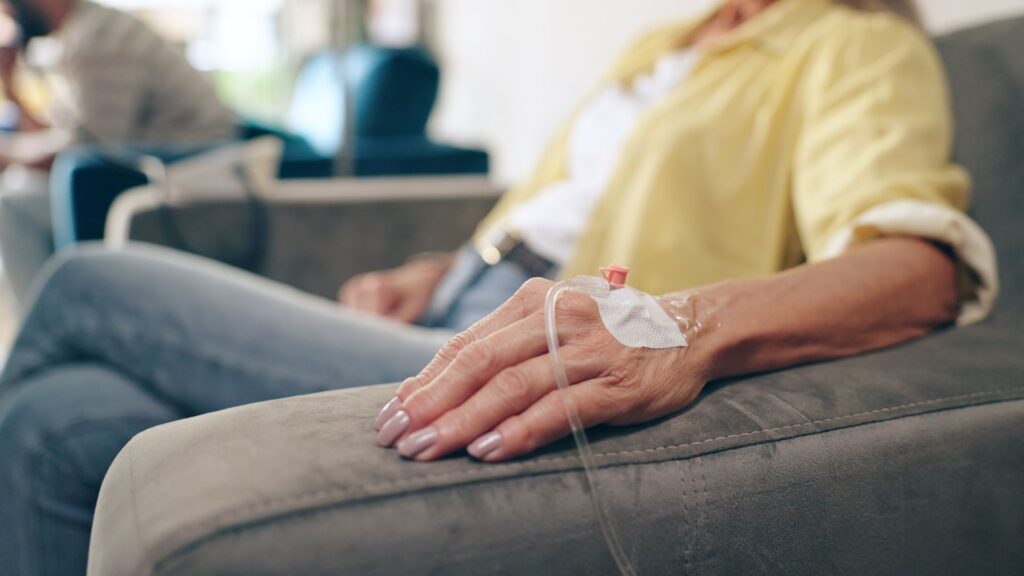Intravenous (IV) therapy is a common medical procedure used to deliver fluids or medications and nutrients directly into the bloodstream. While generally safe, complications can occur. One of the most serious complications is extravasation.
Understanding what extravasation is, how it happens, and how it is managed is essential for both healthcare professionals and patients receiving therapy.

Understanding Extravasation
Extravasation is the unintended leakage of intravenous solutions, particularly vesicant medications, from a vein into the surrounding tissue. Vesicants are drugs that can cause severe irritation and tissue damage if they escape the blood vessel. Unlike simple IV infiltration, which involves the leakage of non-vesicant fluids, extravasation is more dangerous because of the potential for necrosis, blister formation, and long-term damage to the affected area.
The severity depends on several factors, including the type of medication, the amount that leaks out of the vein, and how quickly it is recognized. Timely identification and intervention are essential to prevent serious complications. This underscores the importance of having IV therapy performed by trained professionals who can recognize issues early and respond appropriately.
Causes of Extravasation
Extravasation can occur for several reasons, most of which relate to problems with the intravenous catheter or vein integrity. Common causes include:
- Catheter displacement: If the catheter becomes dislodged or punctures through the venous wall, infusion fluid can seep into surrounding tissue.
- Fragile or small veins: Thin or weak venous walls increase the risk of leakage during infusion.
- Improper insertion: Incorrect placement of the catheter may cause fluids to bypass the bloodstream.
- Repeated venipuncture: Frequent use of the same vein can weaken its structure and raise the risk of extravasation.
Medications that are classified as vesicants carry the highest risk, making proper monitoring essential during administration.
Potential Complications
The complications can range from mild irritation to severe extravasation injury. Vesicants that infiltrate tissue can cause blistering, infection, or permanent scarring. Necrosis, or tissue death, may require surgical intervention to remove damaged tissue.
In severe cases, it can lead to loss of function in the affected area. These risks highlight why prevention, prompt recognition, and immediate treatment are so important in IV therapy.

Treatment and Management
When extravasation is suspected, infusion must be stopped immediately while leaving the IV catheter in place to attempt aspiration of the leaked medication. Treatment strategies often include:
- Cold compress: Applying a cold compress to the affected area helps reduce pain, swelling, and further tissue damage.
- Warm compress: In certain cases, a warm compress may be used to promote absorption, depending on the type of medication involved.
- Elevation: Keeping the limb elevated reduces swelling and promotes circulation.
- Antidotes: Some have specific antidotes that can be administered directly into the tissue through the catheter.
The choice of management depends on the type of drug involved, the extent of leakage, the infusion time, and the patient’s condition. Close monitoring and follow-up care are crucial to ensure recovery and prevent long-term complications.
Prevention Strategies
Reducing the risk of extravasation requires careful monitoring and technique. Proper venipuncture site selection, secure placement of the catheter, and regular inspection around the IV site can significantly lower the chances of IV infiltration and extravasation.
Healthcare providers should educate patients to report pain, swelling, or changes around the site promptly. For high-risk medications like chemotherapy, using a central venous access device instead of a peripheral IV can reduce complications. Consistent observation of the infusion site to help detect early warning signs is key to preventing tissue damage.
Final Thoughts from Quantum Wellness Center
Extravasation in IV therapy is a serious complication that requires immediate attention. Understanding its causes, symptoms, and treatment methods is essential to preventing long-term damage and ensuring safe infusion practices.
At Quantum Wellness Center, patient safety and effective care are our top priorities. Our trained med spa professionals in Sarasota, FL, follow best practices in intravenous therapy, monitoring for complications like infiltration and extravasation to protect patients from unnecessary risks. By combining advanced medical knowledge with attentive care, we provide a safe environment for those receiving IV treatments.



